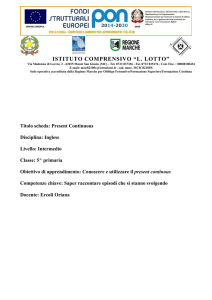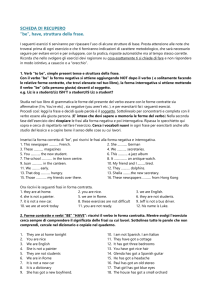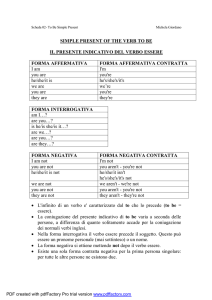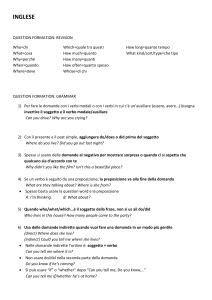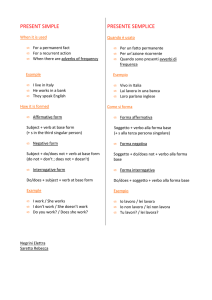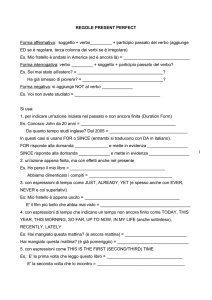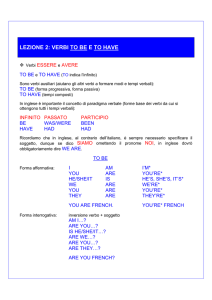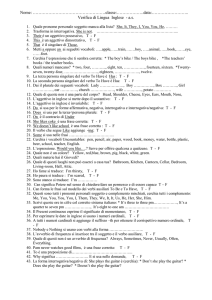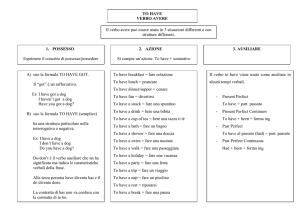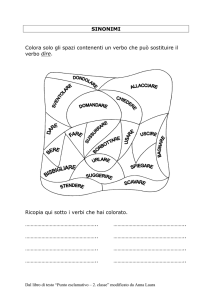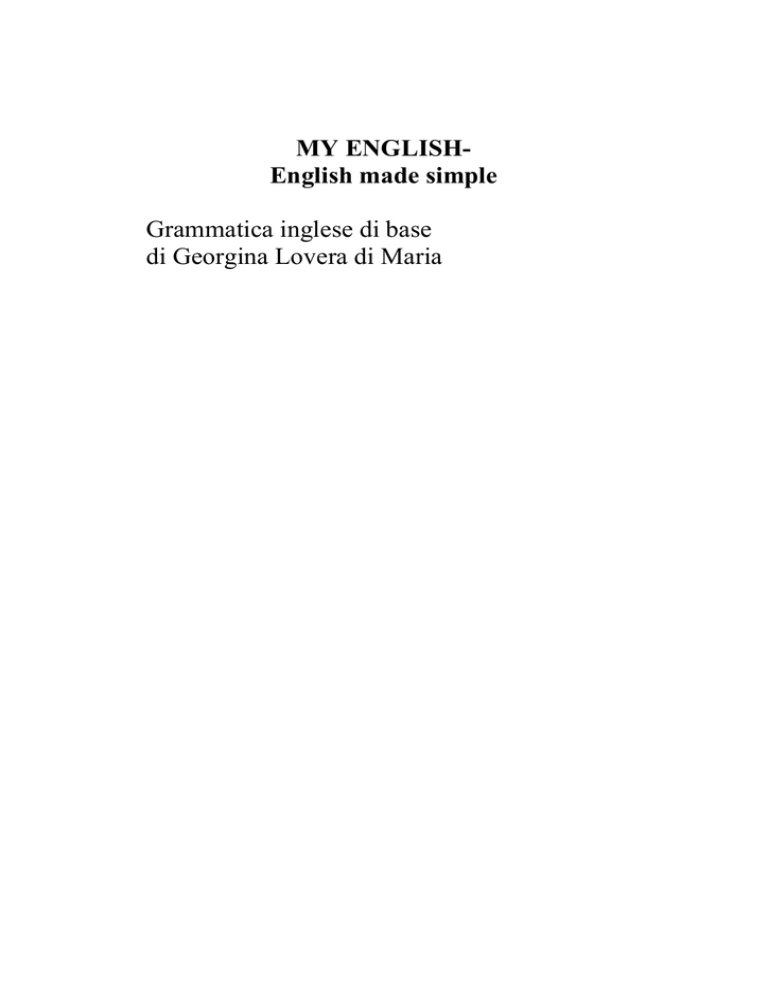
MY ENGLISHEnglish made simple
Grammatica inglese di base
di Georgina Lovera di Maria
CAPITOLO I
PRESENTAZIONI
1.
INTRODUCTIONS IN ENGLAND
" How do you do!" e " Nice to meet you " equivalgono alla forma italiana "
Piacere!"
Si usano quando si incontra una persona per la prima volta.
Es. - " Mary, this is John Smith, John this is Mary Sommers"" Nice
to meet you Miss Sommers."" How do you do Mr. Smith!"Per
presentarsi si può usare anche la formula più semplice:
" I am John " Io sono Giovanni oppure:
" My name is John Brown" Il mio nome è/mi chiamo John BrownLe
persone del verbo sono:
I
= io
You = tu
He = egli
She = ella
It
= esso/a ( neutro, usato per animali e cose)
We = noi
You = voi
They = essi
E' necessario conoscere il presente indicativo del verbo essere.
I am
You are
He is /She is It is
We are
You are
They are
Nel linguaggio parlato si usa di solito la forma abbreviata, o contratta.
Forma contratta:
I'm
You're
He's /She's/ It's
We're
You're
They're
Osserviamo:
Le terze persone singolari sono tre, in quanto gli animali e gli oggetti non
hanno genere in inglese.
Noi diciamo il cane, la sedia.
La sedia è rossa. È la mia sedia.The chair is red. It is my chair.
Quello è un bel cane! E' un labrador.That is a nice dog! It is a labrador.
Come si potrà notare dagli esempi sopra, in inglese il soggetto deve sempre
essere espresso.
In italiano diciamo : È una bella ragazza.
In inglese dobbiamo dire: She is a beautiful girl.
La prima persona singolare , io, in inglese I si scrive sempre con la lettera
maiuscola.
Es. Posso avere un sandwich per favore? Can I have a sandwich please?
In inglese non c'e distinzione fra la forma di cortesia e la seconda
persona singolare " tu ". Le due forme sono identiche.
Il pronome personale You è seconda persona singolare, seconda persona
plurale ( voi ) e comprende anche la forma di cortesia.
Es: " Mi scusi Signora, mi può indicare la strada che porta all stazione?" (
forma di cortesia)
"Excuse me Madam, can you tell me the way to the station?"" Sei
Giovanni?" ( forma confidenziale)
" Are you Giovanni ?""Siete inglesi ?"( seconda persona plurale)
" Are you English?"
Verbo Essere
Forma Interrogativa del Presente Indicativo:
Am I?
Are you?
Is he?
Is she?
Is it?
Are we?
Are you?
Are they?
Forma Negativa del Presente Indicativo:
Forma completa
Forma contratta:
I am not
I'm not
You are not
You aren't
He is not
He isn't
She is not
She isn't
It is not
It isn't
We are not
We aren't
You are not
You aren't
They are not
They aren't
Per quanto riguarda la forma negativa si usa sempre quella contratta quando
si parla o si scrive un breve messaggio. È necessario conoscere la forma
estesa che è usata nella produzione scritta formale.
Risposte Brevi/ Short Answers
"Excuse me, I am Giovanni Rossi. Are you Mr. John Farrar? " /" Mi scusi
,io sono Giovanni Rossi. Lei è il sig. John Farrar?"
" Yes I am. Nice to meet you Mr. Rossi." / "Si, sono io. Piacere di
conoscerla Sig. Rossi ."
Oppure:
" No, I'm not. I'm very sorry." / " No, non sono io, mi dispiace."
Altri usi del verbo essere
• "How are you?" " Come stai ?"
In inglese si risponde sempre " I'm fine thank you/ I'm well thank you/ I'm
Ok thank you." queste espressioni equivalgono alla forma italiana " Sto
bene grazie."
Non è consuetudine parlare dei propri acciacchi a meno che non si sia in
confidenza con chi ce lo chiede.
• Si usa il verbo essere nelle seguenti espressioni:
" I am tired"
"Sono stanco/a "
" I am hungry " "Ho fame "
" I am thirsty " " Ho sete."
Anche l'età si indica con il verbo essere:
" How old are you?" " Quanti anni hai ?" " I am thirty ( years old)" 1 " Ho
30 anni
" How are you?" Come stai? " Fine thank you" oppure " very well thank
you" che equivale a sto molto bene, benissimo grazie.
ESERCIZI :
1. Cerca di capire cosa si dicono Tom e Mike:
Tom: " Hello Mike, how are you?" ------------------------------------------------Mike: " Fine, thank you and you?" ---------------------------------------------Tom : " Very well. Thank you".
---------------------------------------------
2. Adesso completa il piccolo dialogo inserendo le parole mancanti:
Tom : " Hello Mike, -------------- are-----------------?
Mike: " -----------------thank you------------you?"
Tom: " ------------- -------------------- thank you."
3. Ora inventa un dialogo sulla falsariga del n. 1 e 2.
---------------------------------------------------------------------------------------------------------------------------------------------------------------------------------------------------------------------------------------------------------------------------------------------------------------------------------------------------------------------------------------------------------------------------------------------------------------------4. Due persone si conoscono per la prima volta. Osserva il dialogo.
Mr. Bianchi: " Excuse me, I am Paolo Bianchi. Are you Mr. John Smith? "
Mr. Smith: " Yes I am. Nice to meet you Mr.Bianchi."
5. Adesso inserisci le parole mancanti:
1
La parte in parentesi può anche essere omessa. Si può dire "I am 30 years
old "oppure "I am 30."
Mr. Bianchi: " -----------------------me, I -----------Paolo Bianchi. Are --------------Mr. John Smith? "
Mr. Smith: " Yes I-------------. Nice to meet --------------------Mr.Bianchi."
6. Adesso costruisci un dialogo simile:
--------------------------------------------------------------------------------------------------------------------------------------------------------------------------------------------------------------------------------------------------------------------------------------------------------------------------------------------------------------------------7. Completa il dialogo con il tuo amico John:
John : “ Hello Mary , -------------------. “
Mary : “ -------------------------------------------------------------------?”
John : “ where are you from Mary ? “
Mary : “ –(London)-----------------------------------------------------------------“
John : “ I’m from Australia ! “
8. Chiedi dove si trovano i personaggi indicati . Utilizza le informazioni in
parentesi.
- Peter( cinema )
--------------------------------------------? ---------------------------------------------- Wendy ( schhol )
-
-------------------------------------------?---------------------------------------------Mrs. Yorkey ( work )
---------------------------------------------? --------------------------------------------9.
-
Come chiederesti:
Come stai?------------------------------------------Dov’è la scuola ? ----------------------------------Quanti anni hai ? -----------------------------------------Chi è la tua insegnante?-------------------------------------
10. Rispondi.
1. What’s your name?---------------------2. Where are you from?----------------------
3. What’s penna in English?--------------------4. What’s grandfather in Italian?-----------------
11. Completate le frasi inserendo le parole mancanti.
1. “ Good morning Sir, ------------------------------ your --------------?”
2. “ My ----------------is Bond, James Bond. What--------- -------------name
Sir?”
1. “ My name ------------Smith, Paul Smith.”
2. “ Good------------Mr. Smith.”
1. “ --------------morning -------------Bond.”
3. . “ Good morning Madam, ------------------------------ your --------------?”
4. “ My ----------------is Watson, Jane Watson. What--------- ------------name Madam?”
3. “ My name ------------Tailor, Mary Tailor.”
4. “ Good------------Mrs. Watson.”
2. “ --------------morning -------------Tailor.”
Scrivere un curriculum vitae è anche un modo di presentarsi:
In CV heading you can write your general information:
•
•
•
•
•
Name ------------------------------------------------------Surname --------------------------------------------------local address ---------------------------------------------e-mail address -------------------------------------------phone number --------------------------------------------
Questo è un esempio semplice, adatto al livello iniziale. Successivamente
sarete in grado di parlare di voi in modo più dettagliato.
Ora leggiamo un breve testo che riguarda il verbo essere:
READING EXERCISE
Food in Britain
Britain’s most popular ‘fast food’ is fish and chips. The dish is very simple:
fish is dipped in a batter made from flour, eggs and water and then deep
fried in hot fat. Chips are made from thick slices of potato and deep fried.
Per comprendere un testo in una lingua straniera occorre:
1. Cercare parole che si conoscono – es. chips = patatine
2. Capire il contesto
3. Cercare le parti del discorso
Sottolineate il verbo essere nel testo. Ora, con l’aiuto dell’insegnante e di un
piccolo dizionario cercate le parole nuove. Potete tradurre il brano e poi
rispondere in inglese alle domande sul testo.
Traduzione:
----------------------------------------------------------------------------------------------------------------------------------------------------------------------------------------------------------------------------------------------------------------------------------------------------------------------------------------------------------------------------------------------------------------------------------------------------------------------Domande sul testo/ Questions on the text:
1. What is Britain’s most popular dish?--------------------------------------2. how is it cooked?-------------------------------------------------------------3. What is chips in Italian?
Ora è giunto il momento di introdurre le wh-questions, parole usate per
formulare le domande in inglese.
2. Wh- Questions
Si chiamano così alcune parole che iniziano con Wh. Sono essenziali per
formulare domande e sostenere una semplice conversazione:
• Who ?= Chi?
Who is that man? /Chi è quell'uomo?
• What? = Cosa?
What is that ?/Cos'è quello?
• Where?= Dove?
Where is London?/ Dov'è Londra?
• When? =Quando?
When is the lesson?/Quando è la lezione?
• Why? = Perché?
Why are you studying English?/Perché studi l'inglese?
• Which?= Quale ?(fra molti)
Which is your jacket?/ Qual è la tua giacca?
• How? = Come?
How are you?/ Come stai?
• Whose? = Di chi?
Whose is this car? /Di chi è questa macchina?
Esercizi:
1. Completa inserendo l'espressione corretta scegliendo tra Who? What?
Where? When? Why? Which? How? Whose?
1.
2.
3.
4.
5.
6.
7.
8.
"----------------- are you?" " Fine thank you."
"------------------ is that?" " It is a window."
"----------------- is that? " "He is Mr. Brown."
"-----------------are you studying English?" " I need it for work." ( mi
serve per il lavoro)
"----------------- is Rome? " "In Italy."
"----------------- is your jacket?" " The red jacket."
" ---------------- is the dentist appointment?" " At 3.30."
“----------------are these pens?” “ They are my pens”.
Anche I motori di ricerca su internet usano lo stesso principio:
Who
A name, friends names or celebrities. ( pensa ad un nome famoso,
Who
is…?)
What
Select "What" and then search for products, brands, objects or
verbs. ( pensa ad una marca famosa..What is …..?)
When
In this section you can search dates, days or events. ( pensa ad una
data importante, When is…?)
Where The where section is for locations or places. ( pensa ad un luogo
famoso, where is….?)
Exercises:
1.Completa le frasi immaginando di parlare con una persona reale:
You: What-------------------your name?
Mary: I-------------------------Mary Smith, and you?
You: My ------------------is ----------------------------.
Mary: Where-------------------you ----------------------?
You: I am from---------------------------------- and you?
Mary : I am from Britain, from London.
You: Nice ----------------------------Mary.
Mary: How do ------------------do -----------------.
2. Costruisci 4 frasi utilizzando il verbo essere:
1.--------------------------------------------------------2.----------------------------------------------------------3.----------------------------------------------------------4.-----------------------------------------------------------3. Leggi il brano e completa le frasi:
READING EXERCISE
The English love animals, and they love dogs and horses most of all.
Princess Anne, the Queen’s daughter, likes horses very much .
Keeping pets is a popular hobby with children. The British love their pets.
Parents believe that a dog or a cat has a good effect on children. For old
people who live alone a domestic animal is a good companion.
The English love-------------------------The animals they prefer are------------------------------------------------------The Queen’s daughter is-----------------------------------------------------------
She loves----------------------------------------------------------------------------British parents like dogs and cats for the---------------------------------------For old people animals are good--------------------------------------------------
Adesso impariamo i giorni della settimana e i mesi dell’anno…
THE MONTHS OF THE YEAR
January
February
March
April
May
June
July
August
September
October
November
December
THE DAYS OF THE WEEK
Monday
Tuesday
Wednesday
Thursday
Friday
Saturday
Sunday
1. The first day of the weekend:--------------------------------------------------2. The day after Sunday:---------------------------------------------------------3. The first month of the year:--------------------------------------------------4. The last month of the year:---------------------------------------------------CARDINAL NUMBERS
0 zero
1 one
11 eleven
10 ten
2 two
12 twelve
20 twenty
3 three
13 thirteen
30 thirty
4 four
14 fourteen
40 forty (no "u")
5 five
15 fifteen
50 fifty (note "f", not "v")
6 six
16 sixteen
60 sixty
7 seven
17 seventeen
70 seventy
8 eight
18 eighteen (only one "t") 80 eighty (only one "t")
9 nine
19 nineteen
100 one hundred
200 two hundred
…
…
900 nine hundred
1,000
one thousand
2,000
two thousand
…
…
10,000
ten thousand
90 ninety
11,000
eleven thousand
…
…
20,000
twenty thousand
21,000
twenty-one thousand
30,000
thirty thousand
85,000
eighty-five thousand
100,000
one hundred thousand
999,000
nine hundred and ninety-nine thousand (British English)
nine hundred ninety-nine thousand (American English)
1,000,000
one million
ORDINAL NUMBERS
0th
Zeroth ( used in
computer language)
1st
first
11th
eleventh
10th tenth
2nd
second
12th
twelfth
20th twentieth
3rd
third
13th
thirteenth
30th thirtieth
4th
fourth
14th
fourteenth
40th fortieth
5th
fifth
15th
fifteenth
50th fiftieth
6th
sixth
16th
sixteenth
60th sixtieth
7th
seventh
17th
seventeenth
70th seventieth
8th
eighth
18th
eighteenth
80th eightieth
9th
ninth
19th
nineteenth
90th ninetieth
Se la
cifra è:
0
Si
aggiunge
questo
th
suffisso
al
numero:
•
1 2
3 4 5 6 7 8 9
st nd
rd th th th th th th
esempio: 2nd, 7th, 20th, 23rd, 52nd, 135th, 301st.
3.Il Verbo Avere
La parola got serve ad indicare il possesso.
Es: "I have got a new car." " Ho una macchina nuova".
Presente indicativo del verbo to have:
I have got
You have got
He has got
She has got
It has got
We have got
You have got
They have got
Forma interrogativa del verbo to have:
Have I got ?
Have you got ?
Has he got?
Has she got?
Has it got?
Have we got?
Have you got?
Have they got?
Forma negativa del verbo to have:
Forma Completa:
Forma Contratta: 2
I have not got
I haven't got
You have not got
You haven't got
He has not got
He hasn't got
She has not got
She hasn't got
It has not got
It hasn't got
We have not got
We haven't got
2
Per quanto riguarda la forma negativa si usa quasi esclusivamente la forma contratta. La
forma estesa serve solo quando si scrivono lettere o documenti formali.
You have not got
They have not got
You haven't got
They haven't got
Esercizi:
Completa le seguenti frasi indicando le forme opportune di have got
1)
2)
3)
4)
5)
I -------------------------------- a nice radio.
Julia ----------------------------blue eyes.
You-----------------------------a nice pullover.
Peter----------------------------an old bike.
They ---------------------------a big house.
2) Rispondi secondo le indicazioni in parentesi
1) Has Mary got a big dog ? ( yes ) ---------------------------------------------2) Have Peter and Paul got a bicycle ?( no)--------------------------------------3) Has Brenda got a new watch?(yes)-------------------------------------------
1) Traduci:
1) Hai una macchina? --------------------------------------------------------------?
2) Non ho un camper, ma ho una bicicletta.-------------------------------------3) Ho un regalo per te.--------------------------------------------------------------2) Rispondi in modo PERSONALE :
1) Have you got a watch ? --------------------------------------------------2) Have you got your books ? ---------------------------------------------3) Have you got many friends? --------------------------------------------3) Costruisci frasi di senso compiuto.
1) she/has/a/not/bike /got ---------------------------------------------------------2) What/he /got/has/ ?
-------------------------------------------------------3) The/got/Smiths/a/car/have/?-----------------------------------------------------
2. Breve Dialogo:
Mr. White: " Good morning Mr. Brown, how are you?"
Mr. Brown :" Fine thank you Mr. White, and you?"
Mr. White : " Very well thank you. Let me introduce Miss Prism, our new
secretary."
Mr. Brown : " How do you do, Miss Prism!"
Miss Prism : " Nice to meet you Mr. Brown. "
5. Scivi un dialogo simile a quello illustrato. Cambia i nomi, le professioni:
ecco alcuni esempi:
manager = dirigente
computer programmer = programmatore
interpreter = interprete
shop assistant = commesso
nurse = infermiere
Chi svolge le professioni può essere sia uomo che donna, il nome indica
solo il lavoro svolto.
-----------------------------------------------------------------------------------------------------------------------------------------------------------------------------------------------------------------------------------------------------------------------------------------------------------------------------------------------------------------------------------------------------------------------------------------------------------------------4. Il Verbo Can
Questo verbo difettivo si usa per esprimere
1. la capacità, l'abilità es. I can swim = so nuotare
2. per chiedere il permesso di fare qualcosa es. Can I open the window? =
posso aprire la finestra?
E' difettivo in quanto non ha tutti i tempi e si comporta come il verbo essere
e avere nelle forme interrogativa e negativa.
Forma affermativa present simple:
I can
You can
He can
She can
It can
We can
You can
They can
Forma negativa
present simple:
I can not che si contrae e diventa I can't
You can't
He can't
She can't
It can't
We can't
You can't
They can't
Forma interrogativa present simple:
Can I?
Can you?
Can he?
Can she?
Can it?
Can we
Can you?
Can they?
Ecco alcuni esempi:
Can I help you? è la frase che il negoziante rivolge al cliente ed equivale a
posso aiutarla?
Il ragazzo che chiede alla mamma il permesso di uscire dice:
Can I go to the cinema? =posso andare al cinema?
La mamma dirà:
• Yes you can = si, puoi andare
• No, you can't = no, non puoi
a seconda del caso.
Il verbo can si può anche usare per chiedere un favore o come forma di
cortesia per esigere qualcosa.
“ Can you help me please?”/ “ Mi può aiutare, per favore?”
Difficilmente si dirà di no.
Anche il vigile che chiede:
“ Can you show me your driving licence please.” “ Mi può mostrare la
patente per favore”
difficilmente riceverà un rifiuto
Esercizi:
1. Leggi i seguenti mini dialoghi e cerca di capire se il verbo can ha
significato di essere capace o se significa richiesta di permesso o di
favore
1.
2.
3.
4.
5.
Mary:” Mom, can I go to the cinema?” ---------------------------------------John can play football.----------------------------------------------------------I can speak English and Italian------------------------------------------------“ Can I help you sir?”-----------------------------------------------------------“ Can I see your passport please Sir?”
2. Completa le frasi inserendo il verbo can nella forma appropriata:
1. -------------------------I help you?
2. “Can you speak Chinese ?” “ No, --------------------------------------------------------------“
3. “ I’m sorry, but you---------------------------------------------smoke in the
classroom.”
4. “ Mary and John ----------------------------sing very well."
Adesso leggi il brano. Poi prova ad esercitarti con un collega, eventualmente
cambiando la situazione con
At the station / At the bus stop, cercando le parole utili sul dizionario.
READING EXERCISE
At the Airport
Checking In
A. Good morning. Can I have your ticket, please?
B. Here you are.
A. Thank you. Would you like smoking or non-smoking?
B. Non-smoking, please.
A. Would you like a window or an aisle seat?
B. An aisle seat, please.
A. Do you have any baggage?
B. Yes, this suitcase and this carry-on bag.
A. Here's your boarding pass. Have a nice flight.
B. Thank you.
Passport Control
A. Good morning. Can I see your passport?
B. Here you are.
A. Thank you very much. Are you a tourist or on business?
B. I'm a tourist.
A. That's fine. Have a pleasant stay.
B. Thank you.
Key Vocabulary
Can I have your ticket?
smoking, non-smoking
window, aisle seat
baggage, suitcase, carry-on bag
boarding pass
flight
Can I see your passport?
tourist, business
5. Articolo indeterminativo
In inglese l’articolo indeterminativo è a se il sostantivo che segue inizia
per consonante
es. a book, a pen, a dog
Se il sostantivo che segue inizia per vocale l’articolo indeterminativo
aggiunge una n per rendere più facile la pronuncia.
Es : an elephant, an egg, an apple.
L’articolo indeterminativo precede solo sostantivi singolari.
6. Articolo determinativo
L’articolo determinativo inglese è unico per il singolare, plurale, maschile e
femminile e neutro:
the
es. the book, the woman, the men, the dogs
si usa per indicare una particolare persona o cosa, che si conosce o della
quale si è appena parlato.
Es. Jane has got a big house near London. In the house ……
Jane ha una casa grande vicino a Londra. Nella casa….
In inglese l’articolo the rimane sempre invariato.
Non si usa prima di nomi astratti: life /la vita; love / l’amore
7. Il Plurale dei Sostantivi
In inglese i sostantivi formano il plurale aggiungendo una s al singolare.
Es. one dog / un cane
Two dogs / due cani
Tuttavia alcuni sostantivi si comportano in modo irregolare:
• Sostantivi che terminano in ch ( church), in s (plus), in sh ( splash), in x,
z, aggiungono es.
• Sostantivi che terminano in f / fe (leaf /knife) perdono questa desinenza
e prendono ves
Leaves/knives
• Alcuni sostantivi formano il plurale in modo irregolare:
Sing.
Plur.
Man
Men
uomo/uomini
Woman
Women
donna/donne
Child
Children
ragazzo/ragazzi
Foot
Tooth
Mouse
Feet
Teeth
Mice
piede/piedi
dente/denti
topo/topi
8. Some/ any
Le particelle some e any servono ad indicare una parte, una quantità
indefinita.
Es:
“Would you like some cake?”/ vuoi del dolce?
“ Yes please.”
/ si grazie .
Some serve quando si offre qualcosa ( vedi es. sopra) o quandosi indica una
quantità indefinita nelle frasi affermative
Es. “ Can I help you Madam?” / posso aiutarla signora?
“ yes, please. I need some fruit .”/ si grazie, mi serve della frutta:
Any si usa nelle frasi interrogative ( eccetto quando si offre) e negative.
Es: “ have you got any pears?” / Ha delle pere?
We haven’t got any American students/ non abbiamo ( alcun) studente
americano
In italiano la particella negativa alcuno/nessuno si può omettere. In inglese è
obbligatoria.
1) Completa inserendo a/an/the/some,any
1) There are----------pencils in my pencil case
2) My friend Jane is -----------English girl.
3) ---------------film is at 8 o’clock.
4) Look! There is ---------cat in ----------garden.
5) Have you got------------strawberries?
9.Aggettivi Possessivi
My
Your
His
Her
Our
Your
Their
il mio/la mia/i miei/le mie
il tuo/la tua/i tuoi/le tue
il suo/la sua/i suoi/le sue
la sua/il suo/i suoi/le sue
Its
il suo/la sua/i suoi/le sue
il nostro/la nostra/i nostri/le nostre
il vostro/la vostra/i vostri/le vostre
il loro/la loro/le loro/i loro
In inglese l’aggettivo possessivo comprende anche l’articolo.
Ad es. my dog is a labrador/ il mio cane è un labrador
L’aggettivo possessivo si riferisce al genere di chi lo possiede e non al
genere dell’oggetto/persona posseduta.
Ad esempio del marito di una donna si dirà her husband e non, come in
italiano suo marito:
un oggetto 3 , come una penna , che appartiene ad un uomo richiederà his
pen / la sua penna.
L’aggettivo possessivo inglese rimane invariato al plurale.
Ecco alcuni esempi:
My book is new/ il mio libro è nuovo.
Their pens are red/ le loro penne sono rosse.
Their house is big/ la loro casa è grande.
His chair is comfortable/ la sua sedia ( che però appartiene ad un uomo) è
comoda.
Esercizi:
1. Inserisci l’aggettivo possessivo corretto.
1. John is English. -------------------house is in London./ John è inglese. La
sua casa è a Londra
2. Mary lives in Rome. ----------------house is near St. Peter’s./ Maria vive
a Roma. La sua casa è vicino a S.Pietro.
3
Ricorda: in inglese gli oggetti e gli animali sono neutri!
3. My dog is beautiful. ------------------name is Fido./ Il mio cane è
bellissimo. Il suo nome è Fido.
4. Peter and Paul love football. -------------------------team is Milan./ Peter e
Paolo adorano il calcio. La loro squadra è il Milan.
10. Il Genitivo Sassone:
Il genitivo sassone esprime il possesso. Ad esempio la frase John's house
is very big si traduce
la casa di John è molto grande. La particella di si esprime in inglese con '
s.
Il possessore( in questo caso John) viene prima dell'oggetto posseduto (
la casa).
Ecco altri esempi:
• Mary's husband is American/ Il marito di Maria è americano.
• My friends' car is small / la machina dei miei amici è piccola.
In questo caso gli amici sono molti, per cui la 's si limita al solo apostrofo
per evitare difficoltà di pronuncia.
Attenzione:
• The Prince of Wales / Il Principe di Galles è un titolo nobiliare e non
vuole il genitivo sassone, ma la preposizione of / di.
• The legs of the table / Le gambe del tavolo il tavolo è un oggetto e non
vuole il genitivo sassone, ma la preposizione of / di.
Esercizi:
1. Traduci le seguenti frasi utilizzando il genitivo sassone.
1. Il libro di Giovanni è rosso.------------------------------------------------2. La penna di Maria è nuova .-----------------------------------------------3. Il quaderno di Paola è giallo.----------------------------------------------
2. Correggi gli errori ricorda: solo le frasi sbagliate!
1. Jane pencil is old.-----------------------------------------------------------2. Wendy's ruler is white.-----------------------------------------------------3. The bag of the teacher is blue.---------------------------------------------
4. The Prince of Wales is Prince Charles.------------------------------------.
5. Book's Roberta is yellow.--------------------------------------------------6. The dog's bowl is white.-----------------------------------------------------
3. Inventa quattro frasi a piacere utilizzando il genitivo sassone.
1.------------------------------------------------------------------------2.------------------------------------------------------------------------3.-----------------------------------------------------------------------4.------------------------------------------------------------------------
11.Present simple
I verbi italiani hanno le desinenze are/ere/ire.
In inglese le desinenze non ci sono e si parte dall' infinito per formare il
presente
Prendiamo ad es. to work / lavorare la forma presente sarà work
Le desinenze sono:
I work
You work
He works
She works
It works
We work
You work
They work
Come si può notare la terza persona singolare è l'unica che cambia.
Il present simple equivale al presente indicativo italiano, anche se l'inglese
differenzia fra azioni abituali che richiedono il present simple ed azioni che
si stanno svolgendo che richiedono il present continuous.
Il present simple è usato anche per indicare fatti noti come l'es. 3
Ecco alcuni esempi:
1. We go to school every day/ andiamo a scuola tutti i giorni
2. Madonna sings in English/ Madonna canta in inglese
3. Water boils at 100° C. / l'acqua bolle a 100° centigradi
Esercizio:
1. forma il present simple dei seguenti verbi:
- to sing / cantare egli canta -------------------------------------------------- to play /giocare
lei gioca ---------------------------------------------------- to run / correre
noi corriamo----------------------------------------------- to swim / nuotare essi nuotano---------------------------------------------2. Inventa frasi affermative con i seguenti verbi :
1.Play ----------------------------------------------------------------------------------2.Drink---------------------------------------------------------------------------------3.Invite ---------------------------------------------------------------------------------4.Sing ----------------------------------------------------------------------------------Eccezioni:
I verbi che terminano in:
• ss (to kiss/ baciare),
• sh ( to rush/ andare di corsa),
• ch ( to watch /guardare),
• x ( to box / fare la box),
• o ( to go / andare )
aggiungono es alla terza persona singolare anziché solo s
Es:
I kiss
You kiss
He/she/it/ kisses
We kiss
You kiss
They kiss
Forma interrogativa e negativa
Il present simple ha bisogno di utilizzare un verbo ausiliare (do/ does) per la
forma negativa ed interrogativa dei verbi.
Forma interrogativa:
Do I work?
Do you work?
Does he work
Does she work?
Does it work?
Do we work?
Do you work?
Do they work?
Come si potrà notare la terza persona singolare si comporta ancora in modo
irregolare
Esercizio:
1) Trasforma le seguenti frasi in interrogative :
1.Jane likes chocolate/ a Jane piace il cioccolato
•
--------------------------------------------------------------- ?
2.We live in London / vivete a Londra
•
----------------------------------------------------------------- ?
3. They work in Milan / essi lavorano a Milano
•
-------------------------------------------------------------- ?
4. She plays the violin/ Lei suona il violino
•
---------------------------------------------------------------- ?
Forma negativa:
I do not work
You do not work
He does not work
She does not work
It does not work
We do not work
You do not work
They do not work
La particella not indica la negazione ed equivale all'italiano non
Di solito nella conversazione la forma do not diventa don't e does not
diventa doesn't.
Queste forme contratte rendono più agevole la pronuncia e più scorrevole la
conversazione. Es.
I don't work on Sunday / non lavoro di domenica
He doesn't work in a Hotel / egli non lavora in un Hotel
Esercizio:
2) Trasforma le seguenti frasi in negative :
1. Peter likes coke / a Peter piace la coca cola
•
-----------------------------------------------------------------------------
2. They study English/ essi studiano inglese
•
----------------------------------------------------------------------------
3. You play football /tu giochi a calcio
•
------------------------------------------------------------------------------
4. She eats pasta on Sunday/ lei mangia la pasta di domenica
•
---------------------------------------------------------------------------------
12. Present
Continuous
Si usa per:
Azioni in corso es. sto uscendo
Azioni future accompagnate da un’espressione di tempo es. vado alla
stazione domani
Si forma:
Con il present simple del verbo essere accompagnato dal verbo principale
nella forma gerundiva
Forma affermativa:
I am working
You are working
He /she it/is working
We are working
You are working
They are working
Forma interrogativa:
Am I working ?
Are you working?
Is he /she /it /working?
Are we working?
Are you working?
Are they working?
Forma negativa:
I am not working
You are not working
He /she/ it/ is not working
We are not working
You are not working
They are not working
Naturalmente si può utilizzare la forma contratta:
I’m not working
You aren’t working
He/she/it isn’t working
We/you/they aren’t working
I Verbi di sentimento ( like, love, hate ) e di conoscenza ( know, undertand)
non possono essere usati nella forma continuativa:
I love John/ I don’t love John/ Do you love John?
I understand/ I don’t understand/ Do you undersand?
Eccezione: sto cominciando a capire: I’m beginning to understand.
Esempi:
1. What are you doing?
2. I’m doing my homework.
3. Where are you going?
4. I’m going home.
Cosa fai? ( in questo momento)
Faccio i compiti.
Dove stai andando?
Sto andando a casa.
Ma:
1. What do you do?
Cosa fai? ( mestiere)
2. I’m a nurse
Sono infermiera
3. Where do you go on holiday? Dove vai in vacanza abitualmente?
4. I go to the mountains.
Vado in montagna.
Le azioni abituali richiedono sempre il simple present, mentre le azioni in
corso richiedono il present continuous.
Azione abituale
What do you have for lunch?/ cosa mangi a
pranzo?
When do you do your housework?/ quando fai
i lavori di casa?
What do you read?/ cosa leggi?
I read novels. / leggo romanzi
Azione in corso
What are you having for lunch today?/ cosa
mangi a pranzo oggi?
When are you doing your housework this
week?/ quando fai i lavori di casa questa
settimana?
What are you reading?/ cosa leggi, ora o in
questo periodo?
I’m reading a novel/ sto leggendo un romanzo
Il present continuous può anche avere una valenza futura o di durata.
WHAT ARE THEY DOING? COSA STANNO FACENDO?
Am/Is/Are doing
What am I doing?
"I'm standing.
Cosa sto facendo
Sto in piedi.
?
Paola parla di sè
What is he doing? He's sitting.
Cosa sta facendo? E’ seduto
Parliamo di
Mr. Black
Parliamo di
What is she
She's walking.
doing?
Sta camminando
Cosa sta facendo?
Jane
What is it doing? It's running.
Cosa sta facendo? Sta correndo
parliamo del leopardo.
parliamo di Paola e
Roberto
Cosa
facendo noi?
stiamo
What are they
doing?
Cosa stanno
facendo?
They're playing.
Stanno giocando
What are we
doing?
"We are studying English.
Stiamo studiando inglese.
LE AZIONI CHE STIAMO SVOLGENDO IN QUESTO MOMENTO SI
ESPRIMONO CON IL present continuous:
I am working
sto lavorando
You are working
stai lavorando
He is working
-----------------She is working
------------------It is working
-------------------We are working
-------------------You are working
-------------------They are working --------------------Ricorda le persone del verbo:
Le persone del verbo sono:
Singolare:
I
= io
You = tu
He = egli
She = ella
It
= esso/a ( neutro, usato per animali e cose)
Plurale:
We = noi
You = voi
They = essi (maschile, femminile, neutro )
Esempi:
5. What are you doing?
6. I’m doing my homework.
7. Where are you going?
8. I’m going home.
Cosa fai? ( in questo momento)
Faccio i compiti.
Dove stai andando?
Sto andando a casa.
13 Simple Past
Si usa per azioni che si sono ormai concluse nel passato, ed è sempre
accompagnato da un’espressione di tempo come:
yesterday, two days ago, last year, a year ago….
Quando il verbo è regolare si forma aggiungendo la desinenza ed alla radice
del verbo
Forma affermativa:
I worked
You worked
He worked
She worked
It worked
We worked
You worked
They worked
Forma interrogativa:
Did I work?
Did you work?
Did he work
Did she work?
Did it work?
Did we work?
Did you work?
Did they work?
Forma negativa:
I did not work
You did not work
He did not work
She did not work
It did not worked
We did not work
You did not work
They did not work
Naturalmente si può utilizzare la forma contratta:
I/you/he/she/it/we/you/they didn’t work
Se il verbo è irregolare occorre studiare il paradigma:
Es.
To leave = partire
La forma negativa ed interrogativa seguiranno la regola:
I didn’t leave …….
Did you leave?…….
Ecco i paradigmi di alcuni verbi irregolari:
Infinito
To eat
To drink
To sing
To run
To go
To be
Simple past
ate
drank
sang
ran
went
was
Participio passato
eaten
drunk
sung
run
gone
been
To have
To do
To make
had
did
made
had
done
made
To sleep
slept
slept
Esempi:
1.
2.
3.
4.
Where did you go yesterday? Dove sei stato/a ieri’
I went to the cinema, and you? Sono stata al cinema, e tu?
How did you sleep last night? Come hai dormito questa notte?
I slept well thank you.
Ho dormito bene grazie.
Verbo essere:
I was
You were
He/she/it was
We you were
You were
They were
Verbo avere:
I had
you had
he/she/it had
we had
you had
they had
Per gli altri verbi irregolari le persone hanno tutte la stessa forma
Italiano
mangiare
bere
cantare
correre
andare
essere ( verbo
ausiliare)
avere ( verbo ausiliare)
Fare e verbo ausiliare
Fare nel senso di
creare
dormire
Adesso leggi il testo e rispondi alle domande:
READING EXERCISE
Carnival
Notting Hill Carnival- London
The first Notting Hill Carnival took place in 1964 when London’s
Caribbean community introduced the carnival to ease racial tensions. Since
then it has become a popular and colourful annual event celebrated by more
than 2 million Londoners of all backgrounds. The carnival consists of
costume parades, a steel band, jazz and reggae performances, and countless
street vendors selling exotic Caribbean food.
Venue: Notting Hill; Date: Starts 4th Sunday of every August
Carnival was officially born.
1.
2.
3.
4.
When does Notting Hill Carnival take place?
When did it start?
Is it a popular event?
What does it consist of?
14.Past Continuous
Si usa per:
Azioni in corso nel passato
Si forma:
Con il past simple del verbo essere accompagnato dal verbo principale nella
forma gerundiva.
Forma affermativa:
I was working
You were working
He was working
She was working
It was working
We were working
You were working
They were working
Forma interrogativa:
Was I working?
Were you working?
Was he working?
Was she working?
Was it working?
Were we working?
Were you working?
Were they working?
Forma negativa:
I was not working
You were not working
He was not working
She was not working
It was not working
We were not working
You were not working
They were not working
Naturalmente si può usare la forma contratta:
I wasn’t working
You/he/she/it/we/you/they/weren’t working
Esempi:
He arrived while I was working Arrivò quando/ mentre stavo lavorando.
When Mary arrived it was raining Quando arrivò Mary stava piovendo.
While = mentre
When = quando
Invece:
When he arrived I left
volevo vedere).
Quando arrivò andai via ( perché non lo
Adesso leggi il brano e rispondi alle domande :
READING EXERCISE
Guy Fawkes' Day
Guy Fawkes' Day is November 5
In 1605, a person named Guy Fawkes tried to blow up the British
Parliament with 36 barrels of gunpowder. He, and his band of fellow
conspirators, were caught after one of the group sent a letter to King James
of England warning him to stay away from Parliament. Guy Fawkes was
imprisoned and eventually put to death .
Nowadays, the British remember Guy Fawkes' Day (or simply Bonfire
Night) by building bonfires and letting off fireworks. Traditionally, children
made effigies of Fawkes from old clothes stuffed with newspaper, and
display their "Guy" in the streets, asking "Penny for the Guy?", and
expecting to receive some money. Guys were then thrown on the bonfire at
the height of the celebrations.
Big firework displays are organised in public playing fields and open areas,
usually with huge bonfires. The bonfires often take weeks to build, and in
small communities and villages everyone will bring some wood to add to
the pile.
1.Who was Guy Fawkes?
2.What did he do?
3.What happened to him?
4. What happens today?
15. Present Perfect
Questo tempo si utilizza per:
Parlare di azioni che si sono concluse da poco, senza specificare con
esattezza quando
Parlare di azioni che hanno ancora una rilevanza con il presente
Si forma:
Con il present simple del verbo avere accompagnato dal verbo principale
nella forma al participio passato. Viene accompagnato spesso da espressioni
di tempo come just/ appena; ever/mai.
Forma affermativa:
I have worked
You have worked
He/she/it has worked
We have worked
You have worked
They have worked
Forma interrogativa:
Have I worked?
Have you worked?
Has he/she/it worked?
Have we worked?
Have you worked?
Have they worked?
Forma negativa:
I haven’t worked
You haven’t worked
He/she/it hasn’t worked
We/ you/they haven’t worked
Esempi:
I have just finished / ho appena finito
Mary has done all her homework/Mary ha fatto tutti i suoi compiti
Have you ever been to England? Yes I have /Sei mai stato in Inghilterra?
Si, ci sono stato
Who has seen my pen? Chi ha visto la mia penna?
I have/ Io l’ho vista.
Ma:
I saw your pen five minutes ago./ Ho visto la tua penna cinque miniti fa.
Adesso leggi il brano e rispondi alle domande :
READING EXERCISE
Valentine's Day
There are varying opinions as to the origin of Valentine's Day. Some
experts state that it originated from St. Valentine, a Roman who was
martyred for refusing to give up Christianity. He died on February 14, 269
A.D., the same day that had been devoted to love lotteries. Legend also says
that St. Valentine left a farewell note for the jailer's daughter, who had
become his friend, and signed it "From Your Valentine". Other aspects of
the story say that Saint Valentine served as a priest at the temple during the
reign of Emperor Claudius. Claudius then had Valentine jailed for defying
him. In 496 A.D. Pope Gelasius set aside February 14 to honour St.
Valentine.
Gradually, February 14 became the date for exchanging love messages and
St. Valentine became the patron saint of lovers. The date was marked by
sending poems and simple gifts such as flowers. There was often a social
gathering or a ball.
In the United States, Miss Esther Howland is given credit for sending the
first valentine cards. Commercial valentines were introduced in the 1800's
and now the date is very commercialised. The town of Loveland, Colorado,
does a large post office business around February 14. The spirit of good
continues as valentines are sent out with sentimental verses and children
exchange valentine cards at school.
1.What does the legend say about St. Valentine’s origins?
2.Where did he live?
3.When?
4.Who was the note for?
5.What happens on the 14th February?
16 Prepositions
PREPOSITIONS
ON
PREPOSIZIONI
PREPOSITIONS
Equivalente italiano AT
ON
On time
The lesson starts on
time
On Monday
We have English on
Mondays
IN
In orario
La lezione inizia in
orario
IL / DI
Abbiamo inglese il
lunedì
On the table
My pen is on the
table
SU/ SOPRA
La mia penna è sul
tavolo
BETWEEN
The school is
between the Post
Office and the
supermarket
FRA DUE
La scuola è fra la
posta ed il
supermercato
IN FRONT OF
The students are
siiting in front of
each other
ABOVE
The light is above
the desks
DI FRONTE
Gli studenti sono
seduti uno di fronte
all’altro
SOPRA
senza
contatto
La luce è sopra i
banchi
PREPOSIZIONI
Equivalente
italiano
AT
AL/ ALLA
At the station/at 2.30
We arrive at the station Arriviamo alla
at 2.30
stazione all 2.30
NEXT TO
ACCANTO
The blackboard is next La lavagna è
to the teacher’s desk
vicino/accanto alla
cattedra
OPPOSITE
The teacher is
opposite the
students
OVER
DI FRONTE/ DI
RIMPETTO
L’insegnante è di fronte
agli studenti
SOPRA
The helicopter flies L’elicottero vola sopra
over the houses
le case
IN
DENTRO
The pens are in the Le penne sono
pencil case
dentro l’astuccio
TO
VERSO
We go to school on Andiamo a scuola
foot
a piedi
The children are
in/at school
STATO
IN
LUOGO
The children go to
school
MOTO A LUOGO
ENGLISH CONVERSATION
1. WHAT’S THE WEATHER LIKE?
Si parla spesso del tempo nel Regno Unito, ecco alcune espressioni utili:
It’s sunny
It’s a nice day
C’è il sole
E’ una bella giornata
It’s raining
It’s arainy day
It’s cloudy
It’s hazy
It’s snowing
It’s windy
E’ nuvoloso
C’è foschia
nevica
C’è vento
It’s foggy
There is a fog
It’s haling
There is a storm
piove
E’ una giornata
piovosa
E’ nebbioso
C’è la nebbia
grandina
C’è un temporale
The weather forecast:
sunshine
Sole, soleggiato
Cloudy at times
Nuvoloso a tratti
rain
pioggia
Showers at times
Piogge sparse
snow
neve
sleet
nevischio
Ice on the roads
Strade ghiacciate
foggy
Nebbia
It is raining = piove, sta piovendo
There is a storm = c’è un temporale
Temperatures
It’s hot
Fa caldo
It’s warm
E’ tiepido
It’s mild
E’ mite
It’s cool
E’fresco
It’s cold
E’/fa freddo
It’s freezing
Si gela
Keywords:
what’s the weather like today?
What is the temperature like today?
Che tempo fa oggi?
Che temperatura c’è oggi?
2. EATING OUT
I WOULD LIKE….
COULD I HAVE…..
VORREI….
POTREI AVERE…..
May I have the menu please?
Of course sir/madam, here you are
Potrei avere il menù per favore?
Certo signore/signora, tenga
What would you like to start with?
Con cosa desidera cominciare?
I’d like….
vorrei….
Could you tell me what’s in the vegetarian
dish?
Mi potrebbe dire cosa c’è nel piatto
vegetariano?
I think I’ll have….
Penso che prenderò…..
Would you like some more wine?
How about some more salad?
Are you enjoying your meal?
Vuole dell’altro vino?
Che ne direbbe di prendere altra insalata?
Il pasto è di vostro gradimento?
Could you bring me the bill please?
This is on me/ I’ll take this
Potrei avere il conto per favore?
Pago io/ questo lo prendo io
Small Talk
Is this your first trip/visit to Italy?
I hope you enjoy your stay
How was your journey?/ Did you have a good
journey?
I hope your hotel is comfortable
E’ il vostro primo viaggio in Italia?
Spero che il vostro soggiorno sia piacevole.
Com’è stato il suo- vostro viaggio?/Ha –avete
fatto buon viaggio?
Spero che il suo albergo sia comodo
3. MAKING A CALL
Greetings:
Hello/ good morning/ good afternoon
Identify yourself:
I’m Georgina/I’m Mr. Black
Saluti:
Ciao/buongiorno/ buon pomeriggio…
Identificarsi:
Sono…
Get the person you want to speak to
Can I/ May I speak to mr. Smith please?
/Could you put me through to Mr. Black
please?
Farsi passare la persona desiderata:
Posso/potrei parlare con..
Potrebbe passarmi …
Explain the purpose of the call
I’m calling about the tickets
Talk about the main topic:
There is a problem with the new equipment
Spiega le ragioni della chiamata
Chiamo per i biglietti
Parla dell’argomento principale
C’è un problema con la nuova attrezzatura
Discuss the matter:
I believe we should…
Express agreement:
I agree..
Express disagreement:
I’m sorry, but I don’t agree
Discuti il problema:
Credo che dovremmo
Esprimi la tua identità di vedute:
Sono d’accordo..
Esprimi il tuo disappunto:
Mi dispiace, non sono d’accordo
Signal the end of the call:
Well, we can discuss the matter further/I’m
glad we have reached an agreement
Goodbye
Far capire che la conversazione si chiude:
possiamo discutere ancora dell’argomento/
sono felice che abbiamo raggiunto un accordo
Arrivederci
4. BEING POLITE
Can I / May I ?
Can I open the
window?
May I open the door?
Prime persone
Posso aprire la
Of course
finestra?
I’d rather not
Potrei aprire la
Of course
finestra?
I’d rather not
( più formale)
Can we smoke?
Possiamo fumare?
I’m afraid it’s not
allowed
May we smoke?
Possiamo fumare?
Yes of course.
( più formale)
Can I help you ?
Posso aiutarla?
Yes please, I’d like a
T shirt for my son
Can I see your driving Posso vedere la sua
licence please Sir?
patente signore?
May I see your driving Potrei vedere la sua
Of course
licence please Sir?
patente signore?
Here you are
( più formale)
Certo
Preferirei do no
Certo
Preferirei do no
Temo che non sia
permesso
Certo.
Grazie vorrei una T
shirt per mio figlio
Certo
Tenga
Can you?/Could you? Seconde persone
Can you help me please?
Mi puoi/può/potete aiutare per favore?
Could you help me please?
Mi potresti/potrebbe/potreste aiutare per favore?

